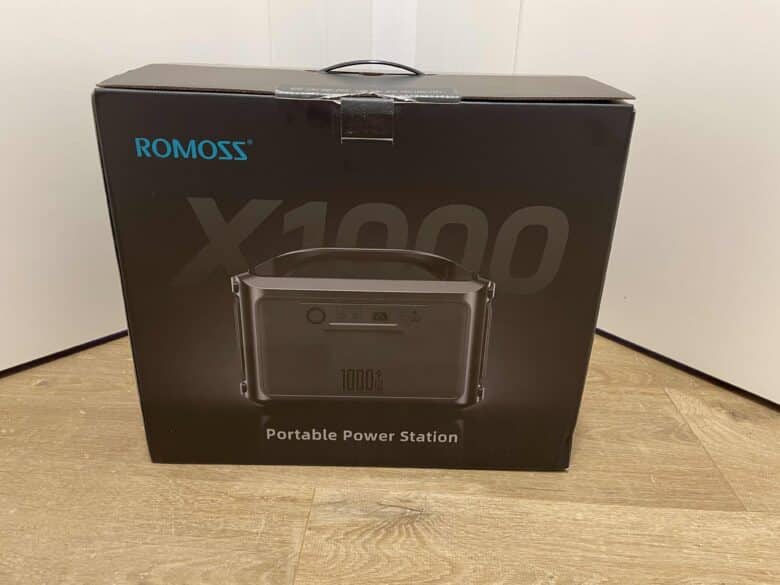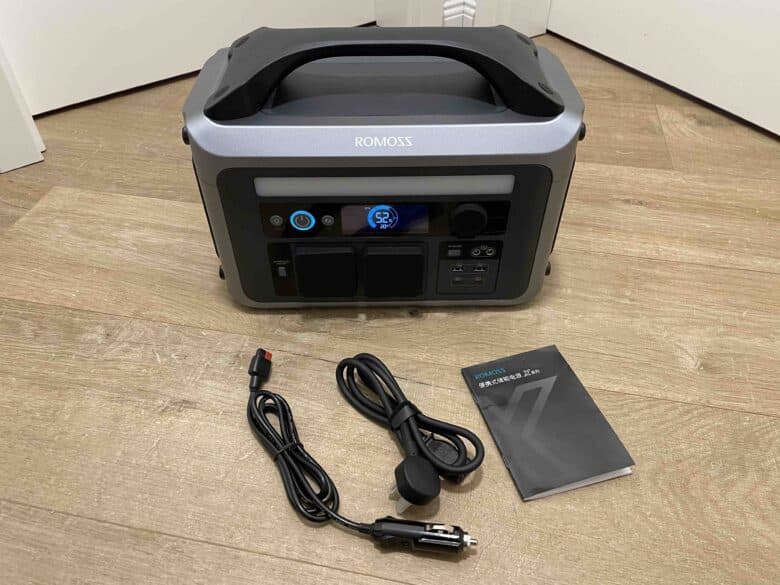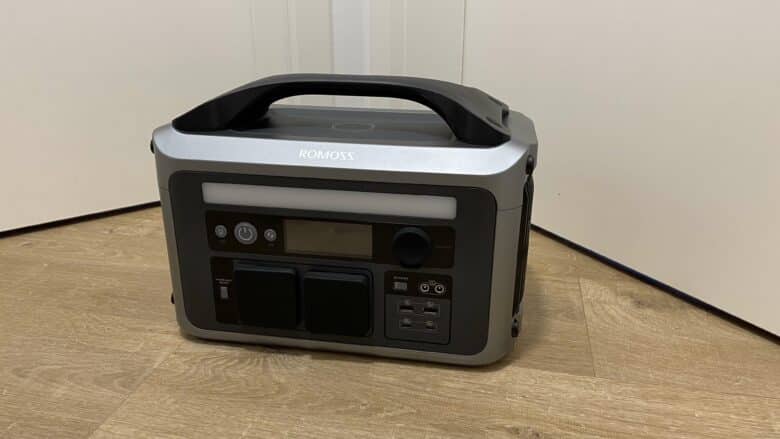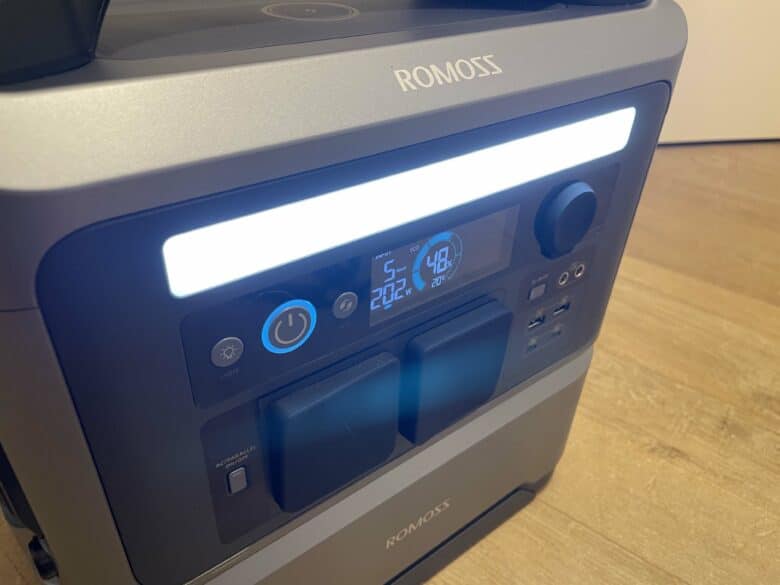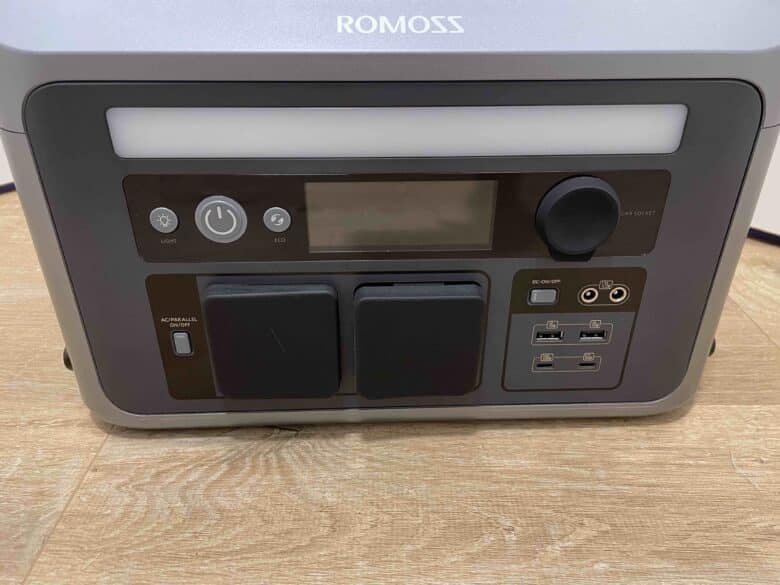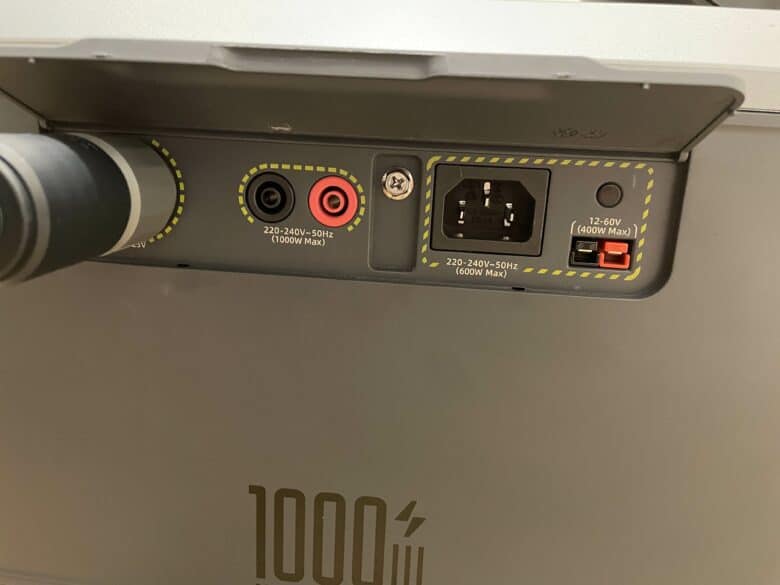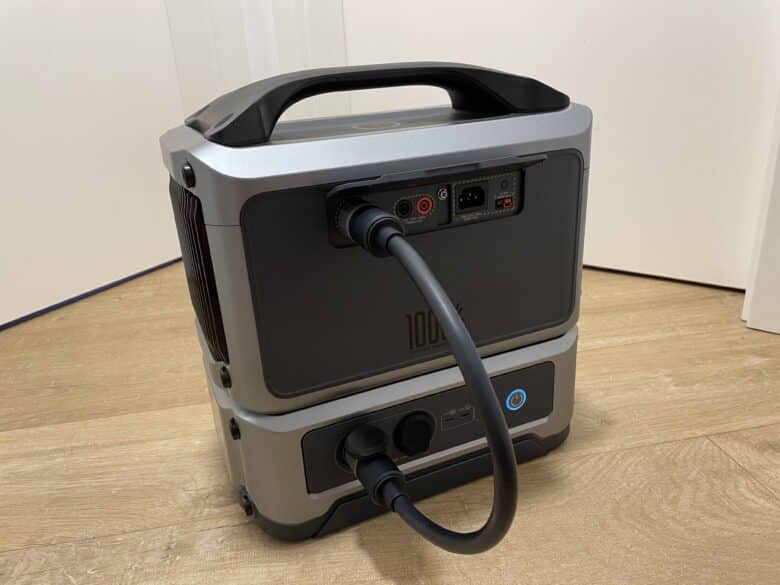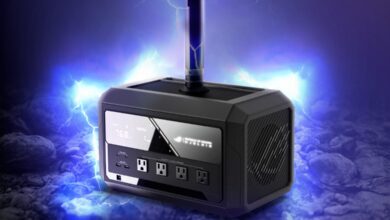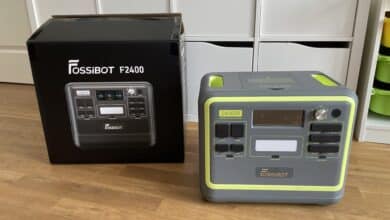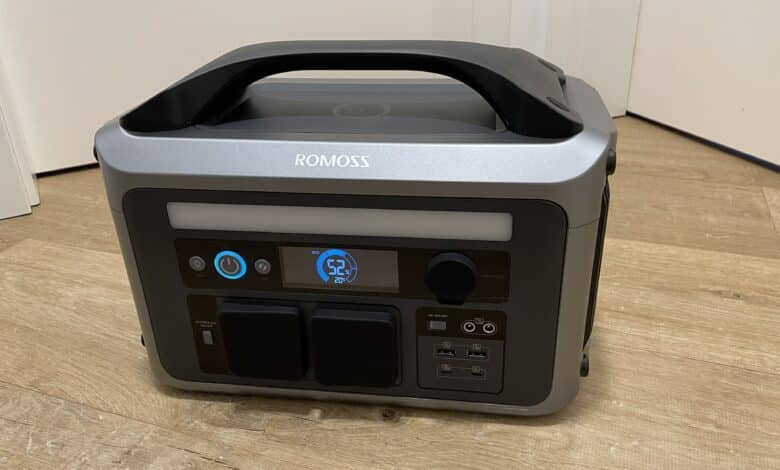
Powerstations are now a dime a dozen. In view of successful top dogs such as Jackery, EcoFlow or Bluetti, newcomers naturally find it difficult to gain a foothold in the market. Success is no longer just dependent on innovative ideas, but also on an extra portion of luck. The Romoss X1000 comes with an exciting magnetic function that ensures practicality and sets the power station apart from traditional models. There are also strong technical features such as LiFePO4 battery cells, which guarantee a service life of 10 years or 3,000 charging cycles. In the Romoss X1000 test, I took a closer look at the Kickstarter project. Can it compete with the market giants?
This is what the Kickstarter project promises
In terms of performance, Romoss faces a challenging environment. With its LiFePO4 technology, a capacity of 1,008 Wh and an output of 1,000 W, the X1000 is certainly not a top performer. I would describe it more as a good average. However, on paper at least, this is more than enough. But in my opinion, Romoss does not want to be a leader in terms of performance. Instead, the manufacturer is clearly focusing on the disciplines of flexibility and practicality.
Why flexibility? The Kickstarter Powerstation can be expanded from its original capacity of 1,008 Wh to an impressive 16,000 Wh. For smaller applications where the almost 1,000 Wh is sufficient, you benefit from its compact size and low weight. The power station can be described as practical, as it comes with an exciting magnetic mechanism. Many different gadgets can be quickly attached to the X1000 itself. Sounds exciting, doesn’t it?
Technical data
| Battery technology | LiFePO4 |
| Battery capacity | 1.008 Wh |
| Constant power | 1.000 W |
| Temporary peak power | 2.000 W |
| Dimensions | 366 × 220 × 260 mm |
| Weight | 13 kg |
| Expandability | Yes, with 4x Romoss X1000 and 12x BE1000 up to 16,000 Wh possible |
| Charging time | AC (max. 600W): 1.5h Solar (max. 400W): 2.5h Car connection (max. 120W): 12h |
| Service life | after 3,000 charging cycles or 10 years still 80% of total capacity |
| Outputs |
|
| Price | from 549 US dollars |
Scope of delivery
Inside the packaging, you will first see a small cardboard case containing the necessary accessories. In addition to an AC charging cable, it also contains a car charging cable and the operating instructions. Once you have removed the cardboard box, you can easily lift the power station out of the packaging using the carrying handle.
Romoss X1000 test: design and workmanship
Even the packaging of the X1000 makes a very good impression. It comes in an elegant matt black and features the name X1000 on the front of the power station. The mobile energy storage unit itself also remains true to the black color scheme. In visual terms, the Powerstation is elegant and cool. The colors black and silver dominate here, which certainly looks classy. With its dimensions of 366 × 220 × 260 mm, the X1000 is in the same league as the Jackery Explorer 1000 Pro(test). If you consider that the latter relies on lithium-ion batteries, this is quite impressive.
After all, their higher energy density means that they can be installed in a more space-saving manner. The different cell technology also explains the difference in weight. While the Jackery weighs 11.5 kg with a comparable total capacity, the Romoss weighs 13 kg. This is comparable to a 70mai Tera 1000(test) or a BougeRV Fort 1000(test), which also rely on LiFePO4. So it may not be a lightweight.
To make transportation as easy as possible, Romoss uses a carrying handle. This makes a stable impression, but also has a decisive disadvantage – it cannot be folded in. Jackery shows how it can be done better with its Pro models, making it easier to stack in the trunk. In terms of workmanship, the X1000 makes a really great impression. You can tell that Romoss has opted for a robust metal frame here. Thanks to ABS and PC materials, the power station should also offer an enormously high level of protection against fire.
Romoss X1000 test: Two lamps on board
A look at the top side not only reveals the carrying handle. You will also find a Qi charging surface here, which you can use to charge your smartphone and other compatible devices. The other outputs are located on the lower front. Above this, you will find a clear display that provides you with the most important status information about the power station. In addition to the battery status itself, you can also view parameters such as input and output power. Physical buttons are located to the left of the display.
In addition to an on/off switch, you will find a button that can be used to activate the wide lamp, which is located in the upper part of the front. On the sides you will find the fans, which are designed to prevent the system from overheating. In addition to the ventilation unit, there is another lamp on the left. This is smaller and creates a cone of light reminiscent of a flashlight. If you wear the X1000, you can therefore use it like an oversized flashlight.
On the back are the connections for recharging the Powerstation battery. The design is logical and self-explanatory. In the test, I always found the right port. Using separate buttons, you can easily activate and deactivate the various connection groups such as AC and DC. This prevents you from saving output power without having to disconnect the cables.
Romoss X1000 test: Qi charging surface on the top
The Romoss X1000 allows you to supply a total of ten devices with power at the same time. This makes it the perfect companion for camping, a barbecue or a long van trip. The variety ensures that you can supply a slimmed-down household with power. A total of two AC ports are available for classic household appliances with a Schuko plug. As we were not provided with an EU version for the test, I plugged in the Schuko plugs using a suitable adapter.
Both AC ports are capable of a constant output power of 1,000 W. In R-Max mode, the power can temporarily increase to 2,000 W if required. You also get two USB-C ports. One USB port provides 60W and the other 100W. Above this are two USB-A ports with 18W power each. Above this are two DC5525 ports, which offer a maximum of 120W.
A cigarette lighter is available as a third DC port, which can also provide 120W of power. A Qi charging surface on the top charges smartphones and other devices with a maximum output of 15 watts. The number of connections should certainly be sufficient for most people. However, other models of this size can offer even more. A prime example is the AlphaESS Blackbee 1000(test). This not only offers one more AC port. You also get two Qi charging surfaces.
Romoss X1000 test: From 0 to 80% in 60 minutes
While you connect the consumers at the front, the connections for charging the battery cells are located at the back. If you want to charge the power station particularly quickly, use the AC input. This allows you to charge the X1000 with a good 600 W. A complete charge then takes just under 1.5 hours. Thanks to the in-house Hypercharge technology, the Powerstation can be charged from 0 to 80% within an hour. This fast-charging capability is super practical when things need to be done quickly.
If there is no power socket nearby, you can of course still charge the X1000. However, the prerequisite for this is that you have a PV module or a suitable car at hand. With the help of a solar module, you can charge with a maximum of 400 W. The battery cells are then fully charged within 2.5 hours. Assuming the best sunny weather, of course! You will need to be patient if you want to charge via the car’s socket. In this case, a maximum of 120 W is possible, which means you need to allow 12 hours for a complete charge.
Romoss X1000 test: Up to 16,000Wh possible
When we talk about the flexibility of the Romoss X1000, we inevitably have to mention the expansion options. The power station comes with just under 1,000 Wh ex works. However, you can increase the capacity to an impressive 16,000 Wh with the right extension. In combination with other storage units, you can turn the Powerstation into a genuine storage system for your own home. For the maximum capacity, you first connect a total of four X1000 Powerstations together.
These then provide a huge power boost. Not only does the capacity itself increase, but also the maximum output power. With two X1000s, there is a total of 2,000 W constant output power. If you even connect four units together, you get an impressive 4,000 W. According to Romoss, this can even be used to charge an electric car.
In addition, up to twelve additional batteries can be connected in the form of the Romoss B1000. In total, you get 16,000 Wh. The Romoss X1000 also proves its qualities as a large-volume energy storage system for your home with its uninterruptible power supply (UPS). Here, the power station quickly becomes an emergency power generator for your own four walls. In the event of a power failure, the power supply is transferred to the X1000 within 10 ms.
Romoss X1000 test: Exciting magnet feature
We are familiar with UPS and expansion options from many other power stations. But what is completely new about the X1000 is its exciting magnet feature. This allows you to attach magnetic gadgets to the X1000.

The manufacturer’s official website gives you a brief insight into the possibilities. For example, Romoss would like to offer a small case, a trolley, a projector stand, a holder for selfies or a special holder for a fan.
Romoss X1000 test: LiFePO4 battery
Romoss is also a contemporary manufacturer when it comes to the choice of battery technology. The LiFePO4 battery cells under the hood not only ensure a long battery life. This modern battery technology is also characterized by its longevity. According to the manufacturer, the X1000 should still have around 80% of its original capacity after 3,000 charging cycles. This corresponds to almost ten years of average use. In direct comparison, a Jackery Explorer 1000 Pro equipped with lithium-ion batteries offers just 1,000 cycles until 80% is reached. The X1000 has a sophisticated Battery Management System (BMS) to further extend its longevity.
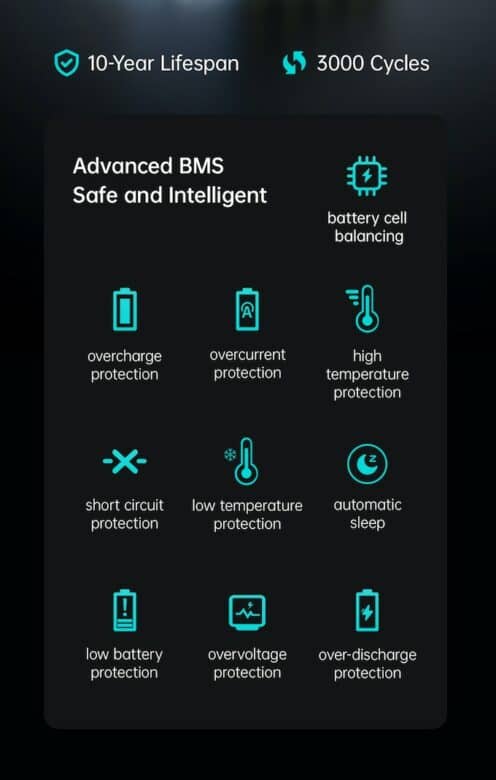
The software ensures that the technology is protected from excessive temperatures and that sufficient ventilation is provided in good time. Conversely, protection against excessively low temperatures is promised. Overcharging protection and an automatic sleep function are also provided. Romoss does everything it can to ensure that the Powerstation can serve as your mobile energy supplier for as many years as possible. When we talk about software, however, we must also mention that the Romoss X1000 does not have its own app. What is not yet, may yet become. However, if remote control and monitoring is important to you, you should definitely keep this in mind.
Conclusion
In the test, the Romoss X1000 proved to be a really great power station. This is partly due to the high-quality design, which is not only attractive to look at. On top of that, the manufacturer has obviously opted for high durability and the plan works. I also find the carrying handle practical. Unfortunately, it is not retractable, which makes transportation in the trunk more complicated. In terms of connectivity, the X1000 is in the good mid-range. The selection will certainly be sufficient for most users, but comparable models allow more consumers to be connected. The expandability of the power station is really impressive.

With the right accessories, up to 4,000 W constant power and 16,000 Wh battery capacity are possible. I also think the feature with the magnetic holders is cool. Some helpful gadgets are likely to develop here over time. Some people will certainly be annoyed by the lack of an app. After all, experience has shown that this provides even more convenience. If the connections are enough for you and you don’t need an app for your power station anyway, then we advise you to buy the X1000 quickly. As a Kickstarter project for super-early-birds, the Powerstation currently costs a mere 549 US dollars. The final retail price is likely to be significantly higher.
Romoss X1000
Design & Workmanship
Hardware
Performance
Value for money
89/100
The Romoss X1000 is a good power station with an extremely innovative magnet feature.
